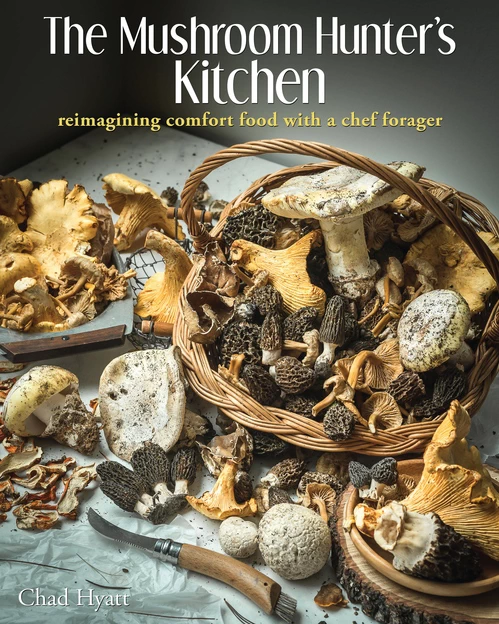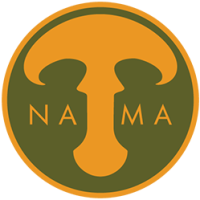I’ll start with the meat of the matter: Chad Hyatt is a California-based chef and mushroom forager; these two facts explain the things I love about his book as well as my reservations about it.
If you like to read cookbooks, you already know what to expect from chef-authors. Hyatt, though, balances chefly refinements and ambition with an adventurous and practical insistence on expanding the range of mushrooms we collect and cook. His encouraging words about Lactarius, Russula, and Hygrophorus: “Not only will learning to enjoy these lesser appreciated edibles help you vastly improve your odds of a successful hunt, but some of them work better for certain types of cooking than the standard prime edibles” (25). This approach should have been part of the book’s title because it distinguishes The Mushroom Hunter’s Kitchen from other mushroom-focused cookbooks.
Hyatt clearly describes how to clean, preserve, taste, and prepare a wide variety of mushrooms. Thanks to his pages on salted mushrooms, and his brilliant ideas about using them much as you use salt cod, I will be salting mushrooms from my fall hauls. Likewise, Hyatt’s mushroom sausage ideas work with what you find, and the book is sprinkled with broth making tips for the less than perfect fungi that sink to the bottom of your basket.
While the content is surprising, the book’s organization is standard cookbook: twelve chapters ranging from breakfast to dessert. Using mushrooms, Hyatt reimagines biscuits and gravy by replacing the sausage in the southern diner version with “mixed mushrooms.” And then there’s the pasta! “Suillus Agnolotti with Fennel Shallot Broth and Hideous Gomphidus Garnish” anyone? Hyatt adds elite cred to this recipe by crediting Thomas Keller’s French Laundry Cookbook for the easy technique.The recipe, he claims, “is an extremely elegant way to serve some of the least appreciated mushrooms you will come across” (162). Maybe so, but come fall, I’ll be making Hyatt’s “Tagliatelle with Bellybutton Hedgehogs and Pine Nuts.” The desserts go way beyond candy caps, including a cauliflower mushroom and kugel! There’s a helpful index and appendices. Elena Feldbaum’s photography, while not stunning, reinforces the excellent information and inspiration that Hyatt’s exposition and recipes provide.
The first recipe I made from this book was “No-Cook Mushroom Syrup.” Hyatt credits Ken Litchfield, of the Mycological Society of San Francisco for the technique. Hyatt gave permission to reprint this lovely recipe here:
No-Cook Mushroom Syrup
(1 lb mushrooms yields about 1 cup syrup)
Chanterelles, matsutake, and almondy Agaricus are my favorite mushrooms for this application, but experiment with whatever you have on hand. Do not use this technique for any mushrooms that require thorough cooking to be rendered safe (e.g. morels or honey mushrooms).
1. Chop cleaned fresh (not dried) mushrooms and toss with sugar in a bowl or jar. For every 100 g of fresh mushrooms you want between 10g and 25 g of sugar.
Note: 10 g will give a mildly sweet syrup while 25 g will be rather sweet, so let your end application decide.
2. Cover and leave for a couple hours at room temperature. At this point, give the ingredients a shake or stir, then refrigerate covered, overnight. I like to give it an extra day in the fridge to make sure the flavor really gets into the syrup. Simply squeeze out and discard the mushrooms, and then strain the liquid for use in desired application. Store extra syrup in the fridge for up to a week.
I used Iowa-foraged chanterelles, and rather than use the gloriously tinted syrup in the gin martini Hyatt describes, I make cocktails from my constantly replenished chanterelle-trimming vodka and Rothman & Winter Orchard Apricot Liqueur.
Inevitably Hyatt highlights mushrooms he finds in California even as he makes his book accessible to all foragers, encouraging the use of the mushrooms you can find in abundance. But as always, I find the formulaic stories about expectation-exceeding forays and displays of abundance both envy and anxiety-provoking. There’s a sort of chest-thumping excess in the photographs of overflowing baskets, the californiacopia of candy caps and boletes that I wish I could find. But I also wish I didn’t have visions of trampled habitats and diminishing harvests, of profit diminishing pleasure. Still, there’s an undeniable generosity of vision and expertise in this book. It is worth the time and shelf space of NAMA members everywhere.
Review by Barbara Ching, 2020


NAMA Store >